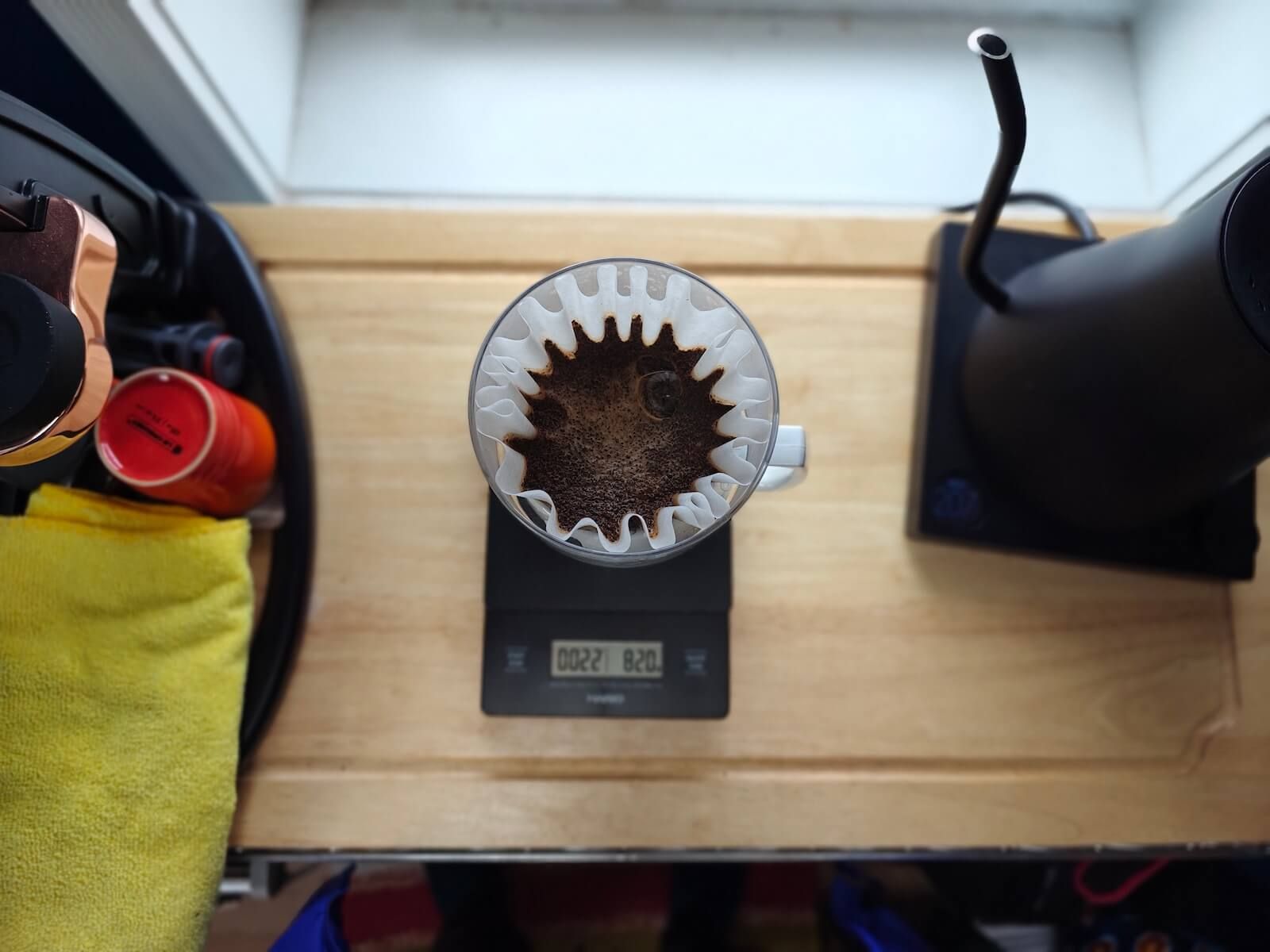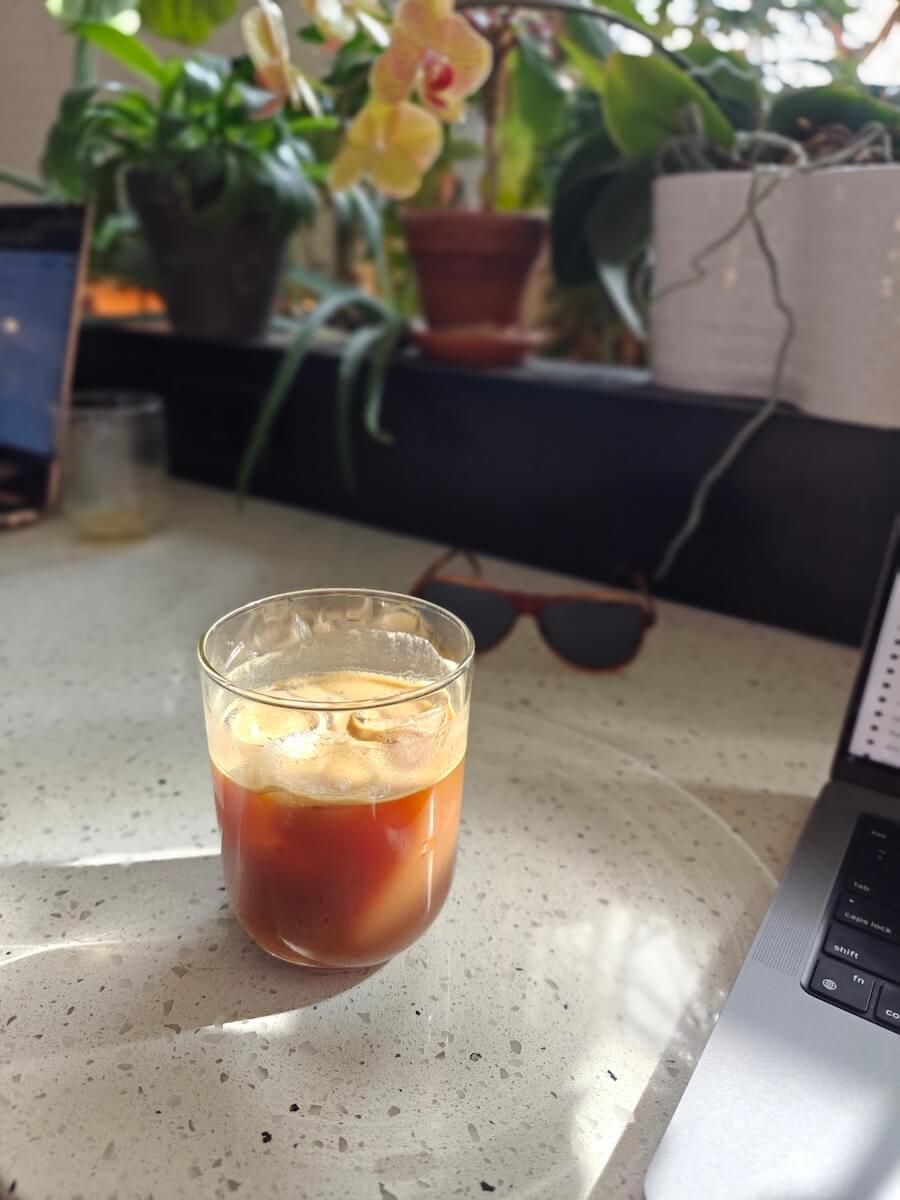Measuring TDS and EXT% of Coffee by Hand
Published
How much coffee is in your coffee?
That’s the question we’re going to answer. In fact I asked this very question over 3 years ago, got my answer, and am now writing this post. 🤓
But first, this post would not exist if it weren’t for Umeko Motoyoshi to whom I’m thankful for writing Not Wasting Coffee, launching the Umeshiso store, and sharing content like this article on coffee extraction. Umeko will come into the picture again later, but I wanted to express my gratitude up front because without them I wouldn’t be writing this. Thanks Umeko! :)
Coffee itself is water soluble—that is to say it’s dissolved in water and how we’re able to brew the beverage of the same name. About 30% of the dry weight of coffee is soluble, so the goal is to dissolve as much as possible without overdoing it. The sweet spot here is about 20%.
 Dissolving some ground coffee in water via the Simplify brewer. Purchased at Umeko’s ecommerce site umeshiso.com.
Dissolving some ground coffee in water via the Simplify brewer. Purchased at Umeko’s ecommerce site umeshiso.com.
The reason to care about this, at all, is 1) I dunno about you but I want to drink tasty coffee and 2) at larger scales (pun not intended) e.g. a cafe being more efficient by optimizing for a higher extraction yield (remember that 20% target) is a way to increase profit margin because there’s simply less input (unbrewed coffee) required to get the same desired output (brewed coffee).
Now, to calculate EXT% (extraction yield; the solids) we need to first know TDS (total dissolved solids). TDS is quite literally the amount of non-water (dissolved coffee solids, minerals, flavors, impurities, etc) in your beverage. A typical brewed coffee will have 1–1.5% TDS and espresso will be around an order of magnitude greater at around 10%. Water by itself is not free from dissolved solids unless you’re using distilled or reverse osmosis (RO) water.
Let’s start there, with the water.
TDS of Water
Devices to measure water TDS can be pretty inexpensive. For example, Third Wave Water sells one. These devices are useful to verify your brewing water TDS content, but unfortunately don’t tell you what the actual mineral makeup is. It’s for this reason that I’ve gotten in the habit of buying RO water from the local co-op and using Third Wave Water mineral satchels to keep the brewing water consistent which let’s me futz around with other brewing parameters like grind size, water temperature, et cetera.
Here are some various samples I’ve taken over the years:
| water sample | TDS (ppm) |
|---|---|
| Third Wave Water (classic) | 198 |
| Reverse Osmosis | 11 |
| St Louis Park, MN tap (cold) | 367 |
| SLP tap Brita filtered | 344 |
| Fredrick-Miller Spring | 449 |
| Minneapolis tap (cold) | 173 |
| Minneapolis tap (hot) | 303 |
Noteworthy is the RO water isn’t quite zero, spring water (expectedly) has hella mineral content, and Third Wave Water is right in the SCA-recommended 75–250 ppm TDS range. I was surprised to see that my hot tap water was 75% higher TDS compared to cold water from the same tap. I’d expect it to be slightly higher due to hot water dissolving more built up mineral deposits from the water pipes, but the larger discrepancy is likely due to TDS meters being calibrated to work at a certain temperature. They work by measuring the conductivity of the water, which changes with temperature. In fact, refractometers designed specifically for measuring coffee TDS are also calibrated for a discrete temperature range.
Now that we’ve covered TDS in water, let’s move on to coffee.
Measuring Coffee TDS by Hand
Devices for measuring coffee TDS are prohibitively expensive, as in several hundred US dollars for the “barista grade” units. Compared to things like high-end espresso machines or grinders, it certainly makes sense, but is a hard sell for me personally since I’m more at the enthusiast (vs professional) level and a high quality coffee TDS refractometer simply would only be used occasionally.
Thankfully, this is where Umeko comes into the picture again when they shared a method for calculating TDS manually using the precision coffee scale you (hopefully) already have:
Make a pour over using a scale, but first:
- Weigh the dry ground coffee + dry filter + dripper. Write that number down. We’ll call that number Dry.
- Then tare your scale and make your pour-over, making sure the coffee bed drips dry and making sure you record exactly how much total water you add. We’ll call that number Total Water.
- Weigh the wet saturated coffee bed + wet filter + dripper. Write that number down. We’ll call that number Wet.
- Subtract Wet from Dry. We’ll call the resulting number Retention.
- Subtract Retention from Total Water (you recorded it in step #2). The resulting number is the amount of water that’s actually in your cup of brewed coffee. We’ll call that number Coffee Water.
- Weigh your brewed coffee, taring out the cup first of course. Record the weight. We’ll call that Beverage Weight.
- Subtract Coffee Water from Beverage Weight. The difference should be the solids extracted.
I was floored the first time I read this, because it simply hadn’t ocurred to me. I asked a couple clarifying questions:
- Wouldn’t you want for the Dry to include the rinsed (wet) filter? That way Retention is ideally only measuring how much water was retained by the coffee itself?
- I believe Retention would be Wet - Dry otherwise you’d end up with a negative number?
Umeko agreed with these so I went forth and tried it with a Hario V60 pour-over brew:
- Dry = 584g (with rinsed [wet] filter)
- Total water = 353g
- Bev weight = 308g
- Wet = 624g
- Retention = 625 - 584 => 41g
- This checks out as the “double your dose” rule of thumb. My “rest of the bag” Dose was ~21.5g
- Coffee water = 353 - 41 => 312g
- 312 + 41 = 353g which was the Total water measurement, so that checks out
- Solids drumroll = 312 - 308 => 4g
After this process I had a few questions for Umeko before getting to my final results:
I subtracted Bev weight from Coffee water so the result wasn’t negative—maybe that means my math is wrong? (Author’s note: the programmer in me would rather just opt to take the absolute value.)
Does this mean that the TDS% is Solids / Coffee water or Solids / Bev weight? As I type this (Author’s note: this was 3+ years ago in 2021, still true in 2024), Solids / Coffee water makes the most sense to me mathematically.
This yields a TDS% of 1.28% which is right in the expected 1–1.5% range.
At Last, EXT%
Now that we have TDS we can calculate extraction yield using an equation supplied by, yet again, Umeko1:
(TDS% * Beverage Weight) / (Dose — [3.5% * Dose]) = EXT%
For me, this yields an EXT% of 19% which is 1) in range and 2) surprisingly optimal.
I have yet to try this with other brewing methods—I’d love to try it with my Flair—but I’d encourage you, dear reader, to do so and report back with your findings. This is the sort of thing that I adore being able to nerd out over and use math in a real-life, pragmatic applications. Taylor Series in Calculus 2 was an entire hellscape, at least with this there’s caffeine at the end of the road. ☕️
 A nice espresso tonic as reward for making it to the end. :)
A nice espresso tonic as reward for making it to the end. :)
The same article linked in the intro: https://urnex.com/blog/measuring-coffee-extraction-and-why-it-makes-people-mad↩︎
I love hearing from readers so please feel free to reach out.